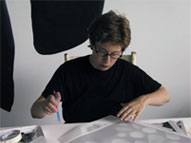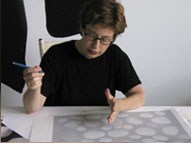About the Artist
Barbara Todd’s work spans more than four decades and combines a minimalist aesthetic with a poetic and politicized sensibility. Though she is best known for her innovative quilts, her oeuvre spans many different mediums and is represented in museums and private collections across Canada and the U.S.
Todd received her B.A. in fine art from the University of Guelph. Through the 1980s she lived and worked at the Banff Centre for the Arts in the Canadian Rocky Mountains. She has taught in the Studio Art Department at Concordia University, Montreal, and in the arts department at Emma Willard School in Troy, New York. She was born in the small town of Galt, in Ontario, Canada.
Artist Statement
“A poet is a man who manages, in a lifetime of standing out in thunderstorms, to be struck by lightning five or six times,” observed Randall Jarrell.
I was struck for the first time by the realization that I could bring all of my childhood knowledge of sewing into the practice of being an artist. I began my first quilt, Cover/Undercover, with a clarity of purpose I had seldom known. Works that followed wed the material and formal qualities of historic quilts to contemporary social issues. The Security Blankets (1988-94) propose a double reading of “security” that sets up a conflict between traditional notions of military and domestic security. With subsequent work I have drawn, layered, cut, sewn, embroidered, woven, and painted my way towards objects and installations always with deep regard for the richness and exactness of the qualities of my materials. A grey fabric is never just a grey fabric. It’s that fabric, in that grey, with that texture and density.
Though my practice has been grounded conceptually and materially in the making of quilts, I have made exhibitions, installations and public commissions that have incorporated other elements and materials: drawings in water-cut steel, sand-blasted glass and vellum, photographs, wall-relief sculptures, and handwoven and embroidered cloth.
I have produced distinct bodies of work, each with its own internal thematic and material consistency, finding sources of imagery and inspiration in poems, historic textiles, children’s drawings, and the immediacy of the everyday.
Whereas my earlier work had a strong critical and political component laden with irony, my current inclination is towards a gentler critique, and, wherever possible, even delight. I have been fortunate to experience the occasional bolt of inspiration. Anticipating the next strike keeps me looking ahead.



